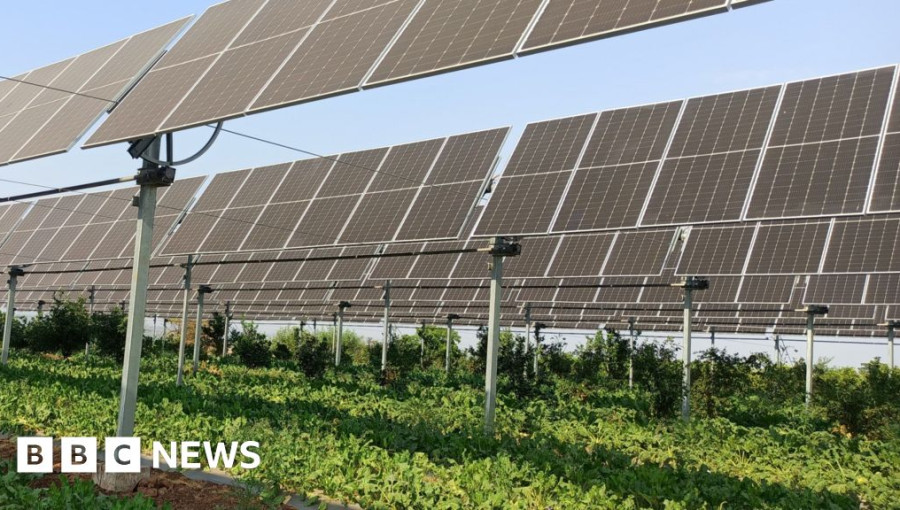The integration of agriculture and solar energy production, known as agrivoltaics, is gaining attention as a potential lifeline for farmers in India facing unpredictable weather and economic challenges. Farmers like Harpal Dagar have benefitted from agreements with solar companies that allow farming to continue beneath elevated solar panels, providing a reliable income source while still cultivating crops. Despite its promise, widespread adoption is hindered by technical, financial, and risk management challenges, with calls for government support to make this model viable for more farmers.
As a farmer, you’re always at the mercy of weather,” says Harpal Dagar who has a farm on the outskirts of Delhi. “So many times, we lost our produce due to unpredictable conditions,” he says. But five years ago he was approached by Sun Master, a Delhi-based solar power firm, with a deal that would give him a much more predictable income. Sun Master proposed building solar panels above some of Mr Dagar’s fields, with the panels high enough off the ground, that he could continue to farm underneath them. Under the 25-year deal, Mr Dagar would receive annual payments and Sun Master would keep the proceeds from the electricity generated. “When the solar company first approached us… many of us feared losing our land. It sounded too good to be true – maybe even a scam,” says Mr Dagar. “But today, I believe it was the best decision I made. My income has tripled, and I sleep peacefully without the stress of climate or crop failure,” he says. Sun Master pays him around $1,200 (£900) per acre, per year, plus $170 a month for work operating and maintaining the solar panels. “Even the turmeric I grow on the same land is mine to sell. How can I complain?”
Siting solar panels above crops goes by the term agrivoltaics. India would seem particularly suited to such innovation. The fortunes of many of its farmers often hinge on an unpredictable monsoon, so a reliable income from a solar energy firm might provide some welcome financial security. But despite the benefits, take up has been slow, around 40 projects are operating in India at the moment, according to the National Solar Energy Federation of India (NSEFI), which represents India’s solar power industry. There are several challenges. Not all crops will grow under solar panels. Depending on the layout, the panels reduce the light getting through by between 15% and 30%. Some denser layouts will block too much sun for staple crops including wheat, rice, soybeans or pulses. “What works well are high-value crops with moderate or low-light needs, like green leafy vegetables, spices such as turmeric and ginger, and some flowers,” says Vivek Saraf, the founder and CEO of Delhi-based SunSeed, which specialises in agrivoltaics.
There’s also the issue of expense. To allow farming underneath, the solar panels need to be at least 11ft (3.5m) off the ground. That makes them between 20% and 30% more expensive to install than panels on a regular solar farm, where they are much closer to the ground. “Small farmers cannot own these systems. They don’t have the risk appetite or capital,” says Mr Saraf. The solar power companies want the government to step in with subsidies to make agrivoltaics more attractive. “In India, where more than 55% of the population depends on agriculture and cultivable land is under mounting pressure, agrivoltaics offers a transformative model,” says Subrahmanyam Pulipaka, CEO of NSEFI. “It reduces irrigation needs, shields crops from heat stress, and stabilizes incomes by diversifying revenue streams for farmers. For rain-fed and climate-vulnerable regions, agrivoltaics can play a vital role in climate adaptation, making agriculture more resilient to unpredictable weather patterns,” he says.
SunSeed gives the farmer multiple options, including continuing to farm

